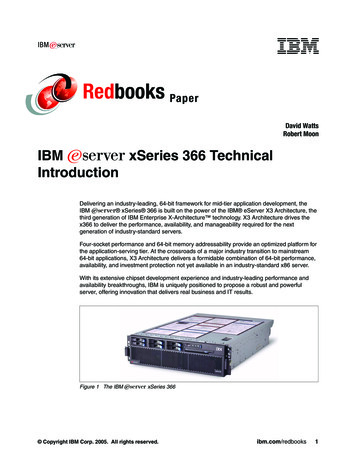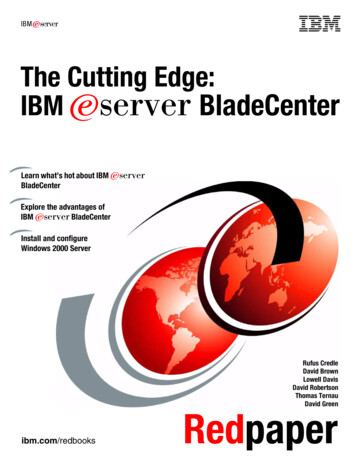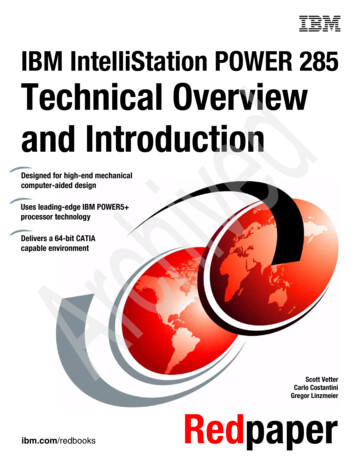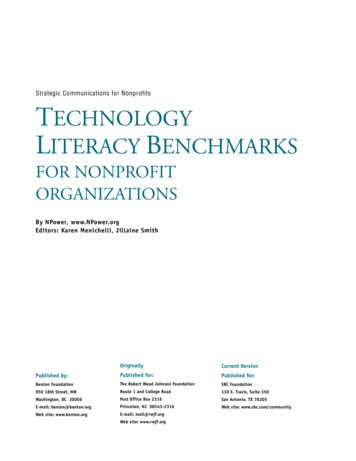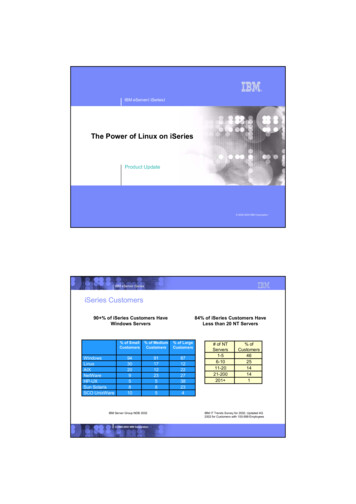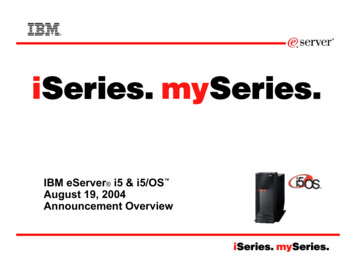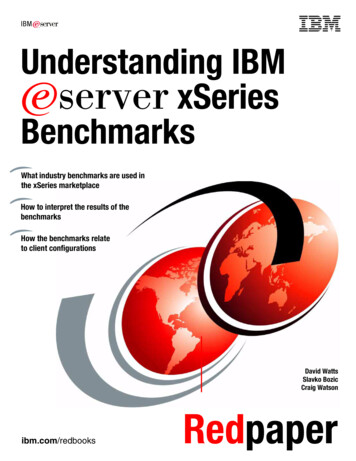
Transcription
Front coverIBMUnderstanding IBMEserver xSeriesBenchmarksWhat industry benchmarks are used inthe xSeries marketplaceHow to interpret the results of thebenchmarksHow the benchmarks relateto client configurationsDavid WattsSlavko BozicCraig WatsonRedpaperClick here to check for updatesibm.com/redbooks
International Technical Support OrganizationUnderstanding IBM Eserver xSeries BenchmarksMay 2005
Note: Before using this information and the product it supports, read the information in “Notices” on page v.First Edition (May 2005)This edition applies IBM Eserver xSeries and BladeCenter servers.This document created or updated on May 13, 2005. Copyright International Business Machines Corporation 2005. All rights reserved.Note to U.S. Government Users Restricted Rights -- Use, duplication or disclosure restricted by GSA ADP ScheduleContract with IBM Corp.
ContentsNotices . . . . . . . . . . . . . . . . . . . . . . . . . . . . . . . . . . . . . . . . . . . . . . . . . . . . . . . . . . . . . . . . . .vTrademarks . . . . . . . . . . . . . . . . . . . . . . . . . . . . . . . . . . . . . . . . . . . . . . . . . . . . . . . . . . . . . . viPreface . . . . . . . . . . . . . . . . . . . . . . . . . . . . . . . . . . . . . . . . . . . . . . . . . . . . . . . . . . . . . . . . . viiThe team that wrote this Redpaper . . . . . . . . . . . . . . . . . . . . . . . . . . . . . . . . . . . . . . . . . . . . viiBecome a published author . . . . . . . . . . . . . . . . . . . . . . . . . . . . . . . . . . . . . . . . . . . . . . . . . viiiComments welcome. . . . . . . . . . . . . . . . . . . . . . . . . . . . . . . . . . . . . . . . . . . . . . . . . . . . . . . . ixChapter 1. Benchmarks 101 . . . . . . . . . . . . . . . . . . . . . . . . . . . . . . . . . . . . . . . . . . . . . . . .1.1 Types of benchmarks . . . . . . . . . . . . . . . . . . . . . . . . . . . . . . . . . . . . . . . . . . . . . . . . . . .1.2 A level playing field . . . . . . . . . . . . . . . . . . . . . . . . . . . . . . . . . . . . . . . . . . . . . . . . . . . . .1.3 A rigorous process means credible results . . . . . . . . . . . . . . . . . . . . . . . . . . . . . . . . . . .1.4 Current industry standard benchmarks . . . . . . . . . . . . . . . . . . . . . . . . . . . . . . . . . . . . . .1.4.1 Evolving benchmarks . . . . . . . . . . . . . . . . . . . . . . . . . . . . . . . . . . . . . . . . . . . . . . .1.5 Invalid comparisons . . . . . . . . . . . . . . . . . . . . . . . . . . . . . . . . . . . . . . . . . . . . . . . . . . . .1.5.1 Server versus workstation benchmarks . . . . . . . . . . . . . . . . . . . . . . . . . . . . . . . . .1.5.2 Apples-to-apples comparison . . . . . . . . . . . . . . . . . . . . . . . . . . . . . . . . . . . . . . . . .1.5.3 Performance versus price/performance . . . . . . . . . . . . . . . . . . . . . . . . . . . . . . . . .1.5.4 Results versus reality . . . . . . . . . . . . . . . . . . . . . . . . . . . . . . . . . . . . . . . . . . . . . . .12334455556Chapter 2. IBM and benchmarks . . . . . . . . . . . . . . . . . . . . . . . . . . . . . . . . . . . . . . . . . . . . 72.1 Why IBM runs benchmarks on xSeries servers . . . . . . . . . . . . . . . . . . . . . . . . . . . . . . . 82.2 Client benefits . . . . . . . . . . . . . . . . . . . . . . . . . . . . . . . . . . . . . . . . . . . . . . . . . . . . . . . . . 82.3 Benchmarks important to IBM . . . . . . . . . . . . . . . . . . . . . . . . . . . . . . . . . . . . . . . . . . . . . 82.4 How xSeries fared . . . . . . . . . . . . . . . . . . . . . . . . . . . . . . . . . . . . . . . . . . . . . . . . . . . . . 102.4.1 The xSeries performance lab . . . . . . . . . . . . . . . . . . . . . . . . . . . . . . . . . . . . . . . . 102.4.2 xSeries and HPC Benchmark Centers . . . . . . . . . . . . . . . . . . . . . . . . . . . . . . . . . 112.4.3 IBM Eserver family . . . . . . . . . . . . . . . . . . . . . . . . . . . . . . . . . . . . . . . . . . . . . . . 112.4.4 Enterprise X-Architecture technology . . . . . . . . . . . . . . . . . . . . . . . . . . . . . . . . . . 142.5 How the industry benefits . . . . . . . . . . . . . . . . . . . . . . . . . . . . . . . . . . . . . . . . . . . . . . . 142.5.1 IBM Center for Microsoft Technologies. . . . . . . . . . . . . . . . . . . . . . . . . . . . . . . . . 152.5.2 Linux Technology Center . . . . . . . . . . . . . . . . . . . . . . . . . . . . . . . . . . . . . . . . . . . 162.6 Examples of xSeries benchmark setups . . . . . . . . . . . . . . . . . . . . . . . . . . . . . . . . . . . . 162.6.1 TPC-C on an xSeries x445 . . . . . . . . . . . . . . . . . . . . . . . . . . . . . . . . . . . . . . . . . . 162.6.2 SPECweb99 on BladeCenter . . . . . . . . . . . . . . . . . . . . . . . . . . . . . . . . . . . . . . . . 17Chapter 3. Industry benchmarks . . . . . . . . . . . . . . . . . . . . . . . . . . . . . . . . . . . . . . . . . . .3.1 What benchmarks are available . . . . . . . . . . . . . . . . . . . . . . . . . . . . . . . . . . . . . . . . . .3.1.1 Transaction Processing Performance Council . . . . . . . . . . . . . . . . . . . . . . . . . . .3.1.2 Standard Performance Evaluation Corporation . . . . . . . . . . . . . . . . . . . . . . . . . .3.1.3 Application and other standardized benchmarks . . . . . . . . . . . . . . . . . . . . . . . . .3.2 Rules of engagement . . . . . . . . . . . . . . . . . . . . . . . . . . . . . . . . . . . . . . . . . . . . . . . . . .3.2.1 TPC rules of engagement . . . . . . . . . . . . . . . . . . . . . . . . . . . . . . . . . . . . . . . . . . .3.2.2 SPEC rules of engagement . . . . . . . . . . . . . . . . . . . . . . . . . . . . . . . . . . . . . . . . .3.3 Selecting the relevant benchmark . . . . . . . . . . . . . . . . . . . . . . . . . . . . . . . . . . . . . . . . .3.4 Workload descriptions . . . . . . . . . . . . . . . . . . . . . . . . . . . . . . . . . . . . . . . . . . . . . . . . . .3.4.1 Online Transaction Processing (OLTP) . . . . . . . . . . . . . . . . . . . . . . . . . . . . . . . .3.4.2 Decision Support (DSS) . . . . . . . . . . . . . . . . . . . . . . . . . . . . . . . . . . . . . . . . . . . .3.4.3 Web servers . . . . . . . . . . . . . . . . . . . . . . . . . . . . . . . . . . . . . . . . . . . . . . . . . . . . . Copyright IBM Corp. 2005. All rights reserved.19202020212122222324242525iii
3.4.4 Application server and ERP . . . . . . . . . . . . . . . . . . . . . . . . . . . . . . . . . . . . . . . . .3.4.5 Mail and collaboration . . . . . . . . . . . . . . . . . . . . . . . . . . . . . . . . . . . . . . . . . . . . . .3.5 Benchmark descriptions . . . . . . . . . . . . . . . . . . . . . . . . . . . . . . . . . . . . . . . . . . . . . . . .3.5.1 TPC-C . . . . . . . . . . . . . . . . . . . . . . . . . . . . . . . . . . . . . . . . . . . . . . . . . . . . . . . . . .3.5.2 TPC-H . . . . . . . . . . . . . . . . . . . . . . . . . . . . . . . . . . . . . . . . . . . . . . . . . . . . . . . . . .3.5.3 TPC-W and TPC-App . . . . . . . . . . . . . . . . . . . . . . . . . . . . . . . . . . . . . . . . . . . . . .3.5.4 SAP Standard Application Benchmark . . . . . . . . . . . . . . . . . . . . . . . . . . . . . . . . .3.5.5 Oracle Application Standard Benchmark . . . . . . . . . . . . . . . . . . . . . . . . . . . . . . .3.5.6 SPEC CPU2000 . . . . . . . . . . . . . . . . . . . . . . . . . . . . . . . . . . . . . . . . . . . . . . . . . .3.5.7 SPECWeb99 and SEPCWeb99 SSL . . . . . . . . . . . . . . . . . . . . . . . . . . . . . . . . . .3.5.8 SPECjAppServer . . . . . . . . . . . . . . . . . . . . . . . . . . . . . . . . . . . . . . . . . . . . . . . . .3.5.9 SPECjbb2000 . . . . . . . . . . . . . . . . . . . . . . . . . . . . . . . . . . . . . . . . . . . . . . . . . . . .262627272829313334353637Chapter 4. Understanding benchmark results . . . . . . . . . . . . . . . . . . . . . . . . . . . . . . . .4.1 Examining a benchmark result . . . . . . . . . . . . . . . . . . . . . . . . . . . . . . . . . . . . . . . . . . .4.2 Finding information . . . . . . . . . . . . . . . . . . . . . . . . . . . . . . . . . . . . . . . . . . . . . . . . . . . .4.3 Disclosure reports . . . . . . . . . . . . . . . . . . . . . . . . . . . . . . . . . . . . . . . . . . . . . . . . . . . . .4.4 Workload characteristics affect system performance . . . . . . . . . . . . . . . . . . . . . . . . . .4.5 Types of benchmarks . . . . . . . . . . . . . . . . . . . . . . . . . . . . . . . . . . . . . . . . . . . . . . . . . .4.5.1 Component level benchmarks. . . . . . . . . . . . . . . . . . . . . . . . . . . . . . . . . . . . . . . .4.5.2 System-level benchmarks . . . . . . . . . . . . . . . . . . . . . . . . . . . . . . . . . . . . . . . . . . .4.6 Benchmark result considerations . . . . . . . . . . . . . . . . . . . . . . . . . . . . . . . . . . . . . . . . .4.6.1 Know what you are comparing . . . . . . . . . . . . . . . . . . . . . . . . . . . . . . . . . . . . . . .4.6.2 Maximum performance versus price/performance . . . . . . . . . . . . . . . . . . . . . . . .4.6.3 Clustered system benchmarks . . . . . . . . . . . . . . . . . . . . . . . . . . . . . . . . . . . . . . .4.7 Benchmark results as part of an evaluation process . . . . . . . . . . . . . . . . . . . . . . . . . .39404041424444444444454546Chapter 5. Client-related benchmarks. . . . . . . . . . . . . . . . . . . . . . . . . . . . . . . . . . . . . . .5.1 Industry benchmarks versus client benchmarks . . . . . . . . . . . . . . . . . . . . . . . . . . . . . .5.2 Alternatives to client benchmarking . . . . . . . . . . . . . . . . . . . . . . . . . . . . . . . . . . . . . . .5.3 Why perform your own benchmarking . . . . . . . . . . . . . . . . . . . . . . . . . . . . . . . . . . . . .5.4 What to expect if you must do your own benchmarking . . . . . . . . . . . . . . . . . . . . . . . .5.5 Traps and pitfalls of doing your own benchmarking . . . . . . . . . . . . . . . . . . . . . . . . . . .5.6 Summary . . . . . . . . . . . . . . . . . . . . . . . . . . . . . . . . . . . . . . . . . . . . . . . . . . . . . . . . . . . .49505052525255Abbreviations and acronyms . . . . . . . . . . . . . . . . . . . . . . . . . . . . . . . . . . . . . . . . . . . . . . 57Related publications . . . . . . . . . . . . . . . . . . . . . . . . . . . . . . . . . . . . . . . . . . . . . . . . . . . . .IBM Redbooks . . . . . . . . . . . . . . . . . . . . . . . . . . . . . . . . . . . . . . . . . . . . . . . . . . . . . . . . . . .Online resources . . . . . . . . . . . . . . . . . . . . . . . . . . . . . . . . . . . . . . . . . . . . . . . . . . . . . . . . .How to get IBM Redbooks . . . . . . . . . . . . . . . . . . . . . . . . . . . . . . . . . . . . . . . . . . . . . . . . . .Help from IBM . . . . . . . . . . . . . . . . . . . . . . . . . . . . . . . . . . . . . . . . . . . . . . . . . . . . . . . . . . .ivUnderstanding IBM Eserver xSeries Benchmarks5959596060
NoticesThis information was developed for products and services offered in the U.S.A.IBM may not offer the products, services, or features discussed in this document in other countries. Consultyour local IBM representative for information on the products and services currently available in your area.Any reference to an IBM product, program, or service is not intended to state or imply that only that IBMproduct, program, or service may be used. Any functionally equivalent product, program, or service that doesnot infringe any IBM intellectual property right may be used instead. However, it is the user's responsibility toevaluate and verify the operation of any non-IBM product, program, or service.IBM may have patents or pending patent applications covering subject matter described in this document. Thefurnishing of this document does not give you any license to these patents. You can send license inquiries, inwriting, to:IBM Director of Licensing, IBM Corporation, North Castle Drive Armonk, NY 10504-1785 U.S.A.The following paragraph does not apply to the United Kingdom or any other country where such provisionsare inconsistent with local law: INTERNATIONAL BUSINESS MACHINES CORPORATION PROVIDES THISPUBLICATION "AS IS" WITHOUT WARRANTY OF ANY KIND, EITHER EXPRESS OR IMPLIED,INCLUDING, BUT NOT LIMITED TO, THE IMPLIED WARRANTIES OF NON-INFRINGEMENT,MERCHANTABILITY OR FITNESS FOR A PARTICULAR PURPOSE. Some states do not allow disclaimer ofexpress or implied warranties in certain transactions, therefore, this statement may not apply to you.This information could include technical inaccuracies or typographical errors. Changes are periodically madeto the information herein; these changes will be incorporated in new editions of the publication. IBM may makeimprovements and/or changes in the product(s) and/or the program(s) described in this publication at any timewithout notice.Any references in this information to non-IBM Web sites are provided for convenience only and do not in anymanner serve as an endorsement of those Web sites. The materials at those Web sites are not part of thematerials for this IBM product and use of those Web sites is at your own risk.IBM may use or distribute any of the information you supply in any way it believes appropriate withoutincurring any obligation to you.Information concerning non-IBM products was obtained from the suppliers of those products, their publishedannouncements or other publicly available sources. IBM has not tested those products and cannot confirm theaccuracy of performance, compatibility or any other claims related to non-IBM products. Questions on thecapabilities of non-IBM products should be addressed to the suppliers of those products.This information contains examples of data and reports used in daily business operations. To illustrate themas completely as possible, the examples include the names of individuals, companies, brands, and products.All of these names are fictitious and any similarity to the names and addresses used by an actual businessenterprise is entirely coincidental.COPYRIGHT LICENSE:This information contains sample application programs in source language, which illustrates programmingtechniques on various operating platforms. You may copy, modify, and distribute these sample programs inany form without payment to IBM, for the purposes of developing, using, marketing or distributing applicationprograms conforming to the application programming interface for the operating platform for which the sampleprograms are written. These examples have not been thoroughly tested under all conditions. IBM, therefore,cannot guarantee or imply reliability, serviceability, or function of these programs. You may copy, modify, anddistribute these sample programs in any form without payment to IBM for the purposes of developing, using,marketing, or distributing application programs conforming to IBM's application programming interfaces. Copyright IBM Corp. 2005. All rights reserved.v
TrademarksThe following terms are trademarks of the International Business Machines Corporation in the United States,other countries, or both:Eserver Eserver ibm.com iSeries i5/OS pSeries xSeries z/OS z/VM zSeries AIX 5L AIX BladeCenter Domino DB2 IBM Lotus Notes OpenPower OS/400 Perform PowerPC POWER Redbooks (logo)ServerProven Tivoli TotalStorage VSE/ESA WebSphere X-Architecture The following terms are trademarks of other companies:Java and all Java-based trademarks and logos are trademarks or registered trademarks of SunMicrosystems, Inc. in the United States, other countries, or both.Microsoft, Windows, Windows NT, and the Windows logo are trademarks of Microsoft Corporation in theUnited States, other countries, or both.Intel, Intel Inside (logos), MMX, and Pentium are trademarks of Intel Corporation in the United States, othercountries, or both.UNIX is a registered trademark of The Open Group in the United States and other countries.Linux is a trademark of Linus Torvalds in the United States, other countries, or both.Other company, product, and service names may be trademarks or service marks of others.TPC benchmark and TPC-C are certification marks of the Transaction Processing Performance Council.SPEC benchmark is a certification mark of the Standard Performance Evaluation Corporation.viUnderstanding IBM Eserver xSeries Benchmarks
PrefaceMany models of the IBM Eserver xSeries family maintained a leadership position forbenchmark results for several years. These benchmarks help clients position xSeries serversin the marketplace, but they also offer other advantages to clients including driving theindustry forward as a whole by improving the performance of applications, drivers, operatingsystems, and firmware.There is a common misconception that industry benchmark results are irrelevant becausethey do not reflect the reality of client configurations and the performance and transactionthroughput that is actually possible in the “real world”. This Redpaper shows that benchmarksare useful and relevant to clients and that benchmark results are useful when attempting tounderstand how one solution offering performs over another.The purpose of this Redpaper is to explain what benchmarks are and how to interpret thebenchmark results so you can understand how they relate to their own server plans. Themajor industry benchmarks from the Transaction Processing Performance Council (TPC) andthe Standard Performance Evaluaction Corporation (SPEC) are described, explaining howthey relate to specific client application types.This paper is for clients, IBM Business Partners, and IBM employees who want tounderstand benchmarks on xSeries servers.The team that wrote this RedpaperThis Redpaper was produced by a team of specialists from around the world working at theInternational Technical Support Organization, Raleigh Center.David Watts is a Consulting IT Specialist at the IBM ITSO Center in Raleigh. Hemanages residencies and produces IBM Redbooks on hardware and software topicsrelated to IBM Eserver xSeries systems and associated client platforms. He hasauthored over 30 redbooks and redpapers, most recently the IBM Redbook, TuningIBM Eserver xSeries Servers for Performance. He has a Bachelor of Engineering degreefrom the University of Queensland (Australia) and has worked for IBM for over 15 years.He is an IBM Eserver Certified Specialist for xSeries and an IBM Certified IT Specialist.Slavko Bozic is an xSeries Technical Specialist and Technical Advisor in Sweden. He haseight years of experience in the IT industry. He holds a degree from the Programme inAutomatic Data Processing at the University of Gothenbourg (Department of Informatics). Hisareas of expertise include server and storage consolidation, Citrix and VMware. He has beenworking for Pulsen, an IBM Business Partner in Sweden for eight years.Craig Watson is an xSeries Technical Specialist in New Zealand. He has nine years ofexperience in the IT industry, and has extensive experience in Windows and UNIX performance tuning. He holds a Masters degree in Electrical Engineering from the Universityof Auckland and has worked at IBM for three years. Copyright IBM Corp. 2005. All rights reserved.vii
The team (l-r): David, Slavko, CraigThanks to the following people for their contributions to this project:Tamikia BarrowMargaret TicknorJeanne TuckerInternational Technical Support Organization, Raleigh CenterChitra BalachandranMatt EcklChris FloydJoe JakubowskiTricia HoganPhil HorwitzDoug PaseTricia ThomasIBM xSeries Performance Lab, RaleighJay BretzmannIBM xSeries Marketing ManagementBecome a published authorJoin us for a two-to-six week residency program! Help write an IBM Redbook dealing withspecific products or solutions, while getting hands-on experience with leading-edgetechnologies. You will team with IBM technical professionals, Business Partners, or clients.Your efforts help increase product acceptance and client satisfaction. As a bonus, you willdevelop a network of contacts in IBM development labs, and increase your productivity andmarketability.viiiUnderstanding IBM Eserver xSeries Benchmarks
Find out more about the residency program, browse the residency index, and apply online atthe following Web address:ibm.com/redbooks/residencies.htmlComments welcomeYour comments are important to us!We want our papers to be as helpful as possible. Send us your comments about thisRedpaper or other Redbooks in one of the following ways: Use the online Contact us review redbook form found at:ibm.com/redbooks Send your comments in an e-mail to:redbook@us.ibm.com Mail your comments to:IBM Corporation, International Technical Support OrganizationDept. HZ8 Building 662P.O. Box 12195Research Triangle Park, NC 27709-2195Prefaceix
xUnderstanding IBM Eserver xSeries Benchmarks
1Chapter 1.Benchmarks 101A benchmark is a standardized problem or test used to measure system performance. Thepurpose is typically to make some sort of comparison between two offerings, whether theyare software, hardware, or both.There are many types of benchmarks undertaken, varying dramatically in purpose, size, andscope. A very simple benchmark may consist of a single program executed on a workstationthat tests a specific component such as the CPU. On a larger scale, a system-widebenchmark may simulate a complete computing environment, designed to test the complexinteraction of multiple servers, applications, and users. In each case the ultimate goal is toquantify system performance to take measurements.This chapter contains the following topics: 1.1, “Types of benchmarks” on page 2 1.2, “A level playing field” on page 3 1.3, “A rigorous process means credible results” on page 3 1.4, “Current industry standard benchmarks” on page 4 1.5, “Invalid comparisons” on page 5 Copyright IBM Corp. 2005. All rights reserved.1
1.1 Types of benchmarksThere are three overall types of benchmarks: Industry-standard benchmarksThis Redpaper concentrates on industry-standard benchmarks.These are many wellknown benchmarks developed, maintained, and regulated by independent organizations.The benchmarks are designed to represent client workloads (for example, e-commerce orOLTP) and allow the reader to make comparisons between systems when the workloadmatches their intended use. The configurations are based on off-the-shelf hardware andapplications. We introduce industry benchmarks in 1.4, “Current industry standardbenchmarks” on page 4. Unregulated benchmarksAlso very common are unregulated benchmarks that are application or componentspecific. You can sometimes purchase or download these benchmark suites to test howspecific components perform.Use extreme caution when using these tools. By far the majority of testing suites availabletest workstation performance and are not relevant for testing server performance. See“Server versus workstation benchmarks” on page 5 for more information. Client workload benchmarksA third category of benchmarking involves benchmarking with a client’s actual workload.This yields the most relevant information, but is difficult to do. We discuss this type indetail in Chapter 5, “Client-related benchmarks” on page 49.Important: In order to test the performance of a server, or to use published benchmarkresults to compare systems, you must understand the characteristics of the intendedworkload. Server performance differs with different workloads. A server that producesindustry-leading performance under one workload, may perform poorly under another.Performance figures from a benchmark or test that do not reasonably resemble theintended workload of a server has limited meaning.The only accurate method of determining how a server will perform under a particularworkload is to test with that environment. Unfortunately this can be very difficult andexpensive for clients to do. For this reason, vendors such as IBM spend a considerableamount of time and money performing industry benchmarks on their servers with differentapplications and workloads. From this, performance information is produced that clients canuse to help make informed decisions.The following sections describes why industry standard benchmarks are necessary, how youcan use the benchmarks, and limitations of which to be aware.Following are some of the many factors that influence performance: The basic configuration modelThe databaseThe disk subsystemThe memory subsystemEspecially the way the application is configured and utilizedThe results of any benchmark, no matter how well it simulates a real-world scenario, cannotbe confidently translated to a user's environment.2Understanding IBM Eserver xSeries Benchmarks
The published results of industry standard benchmarks are extremely useful approximatesrather than definitive, guides to relative performance, if real workload testing is not practical.1.2 A level playing fieldHow can you compare and evaluate the performance claims of one vendor against those ofanother? In the early 1980s it was generally recognized that metrics such as millions ofinstructions per second (MIPS) were inadequate for gauging the performance of a serverexecuting an Online Transaction Processing (OLTP)-type workload. Hardware vendors at thetime began quoting the performance of their systems in terms of transactions per second(tps), but they revealed few details of the tests used to produce such figures. This made itextremely difficult to make informed comparisons between different systems.In 1984, a new benchmark was proposed that was intended to be vendor neutral. Therequirements of the benchmark were described at a high functional level, rather thandistributed as an executable program. This was an important distinction in contrast to otherbenchmarks at that time, because it allowed the test to be implemented on any type ofhardware or software. The development of this benchmark was essentially the beginnings ofthe Transaction Processing Performance Council (TPC), an independent organization that isresponsible for creating effective benchmarks, and for ensuring that the rules of thebenchmarks are followed.At around the same time, a small group of workstation vendors established another non-profitorganization to create and monitor standardized CPU benchmarks. Both this organization,named the Standard Performance Evaluation Corporation (SPEC), and TPC developed intothe most recognized and widely accepted industry standardization bodies for performancetests.You can find information regarding these organizations the following Web sites:http://www.tpc.org/http://www.spec.org/1.3 A rigorous process means credible resultsIndustry standard benchmarks are performed in accordance with a tightly defined set of rules.These rules are agreed upon amongst participants, and a mechanism for ensuring that therules are followed is put in place. In the case of the TPC benchmarks, an independent auditorreviews and verifies the benchmark result before it can be released.A full disclosure report is also published that details all components of the benchmark,including the hardware, software, and every parameter setting required to reproduce theresult. This process enables competitors to examine how the performance figure wasachieved, learn tuning techniques, and challenge the result if any rules were broken.The degree of scrutiny to which these benchmark results are subjected means that they areextremely credible. Although the actual performance figures reached are generally notrealistic in a production environment, the results demonstrate the relative strengths of asystem architecture under that type of workload.A further discussion about the industry benchmark process can be found in 3.2, “Rules ofengagement” on page 21.Chapter 1. Benchmarks 1013
1.4 Current industry standard benchmarksThere are a large number of industry standard benchmarks available, the TPC and SPECmaintain the most widely recognized and accepted ones. Benchmarks that are specific to anapplication are also often quoted, for example Oracle Applications Standard Benchmark andSAP Standard Application Benchmark. Table 1-1 shows a number of the current industrystandard benchmarks available, and the nature of workloads that they represent.These benchmarks are discussed further in Chapter 3, “Industry benchmarks” on page 19.Table 1-1 Common benchmarks and the workloads they representBenchmarkType of workloadTPC-C and TPC-EOnline transaction processingTPC-HAd-hoc decision supportTPC-W and TPC-AppTransactional Web e-CommerceSPECwebWeb serving static and dynamic pagesSPECweb SSLWeb serving with Secure Sockets Layer (SSL)SPECjbbServer-side Java SPECjAppServerJ2EE-based application serverSPEC HPCHigh performance computing, CPU, interconnect, compiler andI/O subsystemsSPEC CPUCompute intensive, integer and floating point performanceOracle ApplicationsModels the most common transactions on the seven most usedOracle Application modulesSAP Standard ApplicationSuite of benchmarks for mySAP Business Suite.BaanERPTransaction processing environment of iBaan ERP applicationsNotesbenchSimulates Domino workstation-to-server or server-to-serveroperationsExchange MAPI MessagingMeasures the maximum messagingthroughput of a Microsoft Exchange ServerLinpack HPLSolving a dense system of linear equationsUsed to compile the top 500 supercomputer list.1.4.1 Evolving benchmarksIndustry standard benchmarks are generally designed to simulate realistic applicationworkloads. However, as business and technology evolves, application workloadcharacteristics change as a result. A benchmark that successfully replicated a productionworkload five years ago, may have little resemblance to the workloads that clients use today.For this reason, new benchmarks are constantly being developed that more accuratelyrepresent production environments.An example of this is TPC-C, regarded by many as the industry’s premier benchmark.Although this benchmark effectively highlights strengths in system design, most accept that itno longer represents configurations that clients purchase. Us
International Technical Support Organization, Raleigh Center. David Watts is a Consulting IT Specialist at the IBM ITSO Center in Raleigh. He manages residencies and produces IBM Redbooks on hardware and software topics related to IBM Eserver xSeries systems and associated client platforms. He has
